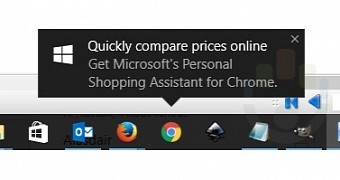If you’re an early adopter of Windows 10, you probably know that Microsoft is trying to help users make the most of the operating system by highlighting some of its features with notifications that are more or less intrusive.
Some people call it “ads,” Microsoft says they’re just “tips notifications,” but no matter what they are, they’re definitely something that most users want to disable (and they can do that from Settings app > Personalization > Start > Occasionally show suggestions in Start).
In the default Windows 10 configuration, however, these notifications are turned on, so users who didn’t disable them get to see such popups every once in a while.
One of the latest “ads” showing up on Windows 10 took many by surprise because, while it does advertise a Microsoft product, it’s actually an extension for Google Chrome. Given the fact that Microsoft has been pushing really aggressive for Edge, seeing the company recommending a Google Chrome extension is certainly something we didn’t see coming.
You can disable these notifications
The extension in question is Personal Shopping Assistant, which is supposed to improve shopping with features that let them favorite products they find online, monitor prices, and compare a specific item at multiple retailers. The extension is available for the majority of browsers, including Google Chrome, Mozilla Firefox, Opera, and yes, Microsoft Edge.
So instead of promoting Personal Shopping Assistant for Google Chrome, why isn’t Microsoft promoting the very same extension but for Edge browser? Hard to say, but Google Chrome is one of Edge’s biggest rivals, with the software giant originally aiming to make all Chrome extensions work on its browser with little to no modifications.
As far as these “ads” are concerned, Microsoft says they’re not supposed to be intrusive by any means, but only helpful because they highlight some of the Windows 10 features that users might not know about. On the good side, users can actually disable them should they feel like they don’t need such notifications, although it often happened for the default configuration to be restored when installing large OS updates.

 14 DAY TRIAL //
14 DAY TRIAL //